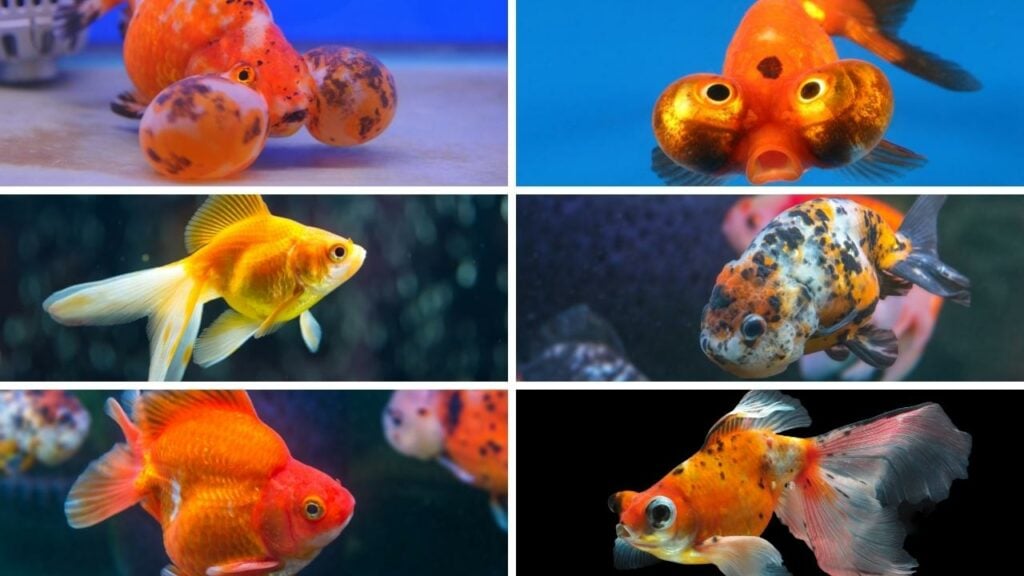
Goldfish are a very popular choice in the aquarium hobby. Winning my first goldfish at the fair is what got me into fishkeeping many years ago.
There are many different types of small goldfish available. They come in a variety of shapes and sizes that have their own set of requirements and unique looks.
- How Big Does a Small Goldfish Grow?
- What is The Smallest Goldfish?
- Small Goldfish Sizes – A-Z
- 17 Small Goldfish Types
- 1. Bubble Eye Goldfish
- 2. Butterfly Tail Goldfish
- 3. Celestial Eye
- 4. Egg Fish Goldfish
- 5. Fantail Goldfish
- 6. Jikin Goldfish
- 7. Lionhead Goldfish
- 8. Oranda Goldfish
- 9. Pearlscale Goldfish
- 10. Pompon Goldfish
- 11. Ranchu Goldfish
- 12. Ryukin Goldfish
- 13. Tamasaba Goldfish
- 14. Telescopic / Moor Goldfish
- 15. Tosakin Goldfish
- 16. Veiltail Goldfish
- 17. Wakin Goldfish
- Things To Consider Before Getting A Small Goldfish
- Closing Thoughts On Smallest Types Of Goldfish…
How Big Does a Small Goldfish Grow?
A small goldfish can be anywhere from 5-10 inches in length, depending on what breed you choose.
There’s no such thing as a tiny goldfish, they grow much bigger than most people realize!
What is The Smallest Goldfish?
The smallest goldfish is the bubble eye, which grows to around 5 inches in length, so this guy is the closest you’ll get to a miniature goldfish.
Small Goldfish Sizes – A-Z
| GOLDFISH TYPE | FULLY GROWN SIZE |
| Black Moore | 10 inches (25cm) |
| Bubble Eye | 5 Inches (12.5cm) |
| Butterfly | 5-8 inches (12.5cm-20cm) |
| Celestial Eye | 6 inches (15cm) |
| Egg Fish | 6 inches (15cm) |
| Fantail | 6-8 inches (15cm-20cm) |
| Jikin | 9 inches (23cm) |
| Lionhead | 5-8 inches (12.5cm-20cm) |
| Oranda | 7-9 inches (17.75-23cm) |
| Pearlscale | 6-8 inches (15cm-20cm) |
| Pompon | 6 inches (15cm) |
| Ranchu | 5-8 inches (12.5cm-20cm) |
| Ryukin | 10 inches (25cm) |
| Sabao | 10 inches (25cm) |
| Tamasaba | 10 inches (25cm) |
| Telescopic | 10 inches (25cm) |
| Tosakin | 6 inches (15cm) |
| Veiltail | 7 inches (17.5cm) |
| Wakin | 10 inches (25cm) |
17 Small Goldfish Types
Let’s get to why you are here and go over the 17 smallest goldfish breeds and their care requirements, so you can choose the perfect pet goldfish.
1. Bubble Eye Goldfish

- Name / Scientific Name: Bubble Eye Goldfish / Carassius auratus
- Care Level: Intermediate
- Temperament: Peaceful
- Maximum Size: 5 inches
- Minimum Tank Size: 20 gallons
- Diet: Omnivore
- Water Temperature: 65°-72°F
- dKH: 5-19
- pH: 7.0-8.0
The bubble eye goldfish is one of the quirkiest fish you’re ever likely to see and the smallest fancy goldfish available.
Bubble eyes are very peaceful and will get along with other peaceful fish.
I don’t recommend this fish if you’re a beginner as they’re super sensitive to dirty water.
Suitable for an appropriately decorated and well-maintained aquarium only, do not put the bubble eye in a pond.
Growing to a maximum of 5 inches, they have an egg-shaped body with no dorsal fin. They come in various colorations including red, calico, black, chocolate, and blue.
The bubbles around the eyes are liquid-filled sacs. They’re very delicate and can be easily damaged if they’re bumped into, so it’s vital not to have any sharp objects in their tank.
Coupled with the lack of a dorsal fin, the eye sacs also make the bubble eye a slow swimmer and not very agile. This means it can easily be left without any food if its tankmates can swim faster.
Suitable tank mates are similarly slow-swimming fish such as moors, lionheads, and celestial eyes.
2. Butterfly Tail Goldfish
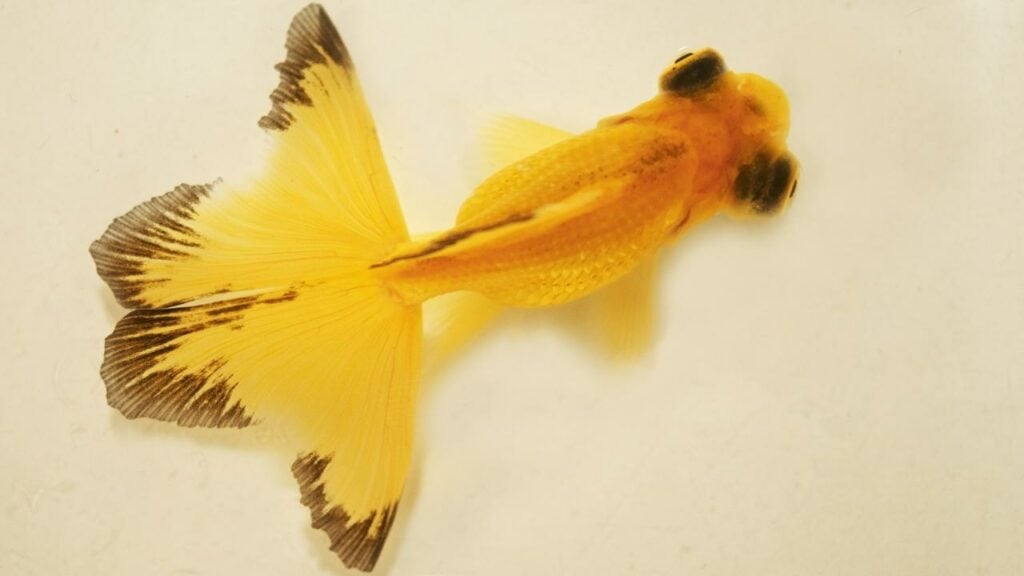
- Name / Scientific Name: Butterfly Tail Goldfish / Carassius auratus
- Care Level: Intermediate
- Temperament: Peaceful
- Maximum Size: 5-8 inches
- Minimum Tank Size: 20 gallons
- Diet: Omnivore
- Water Temperature:65°-72°F
- dKH: 5-19
- pH:7.0-8.0
The butterfly tail is a genetically bred variant of the moor goldfish that, as the name suggests, has a tail that’s shaped like a butterfly when viewed from above.
Prone to illnesses they’re not recommended for beginners or ponds.
Peaceful in nature, growing to around 5 inches, but can reach 8 inches with the right care.
Available in black, calico, red, and white colorings.
They shouldn’t be housed with faster swimming fish due to being a slow swimmer and having delicate fins.
3. Celestial Eye
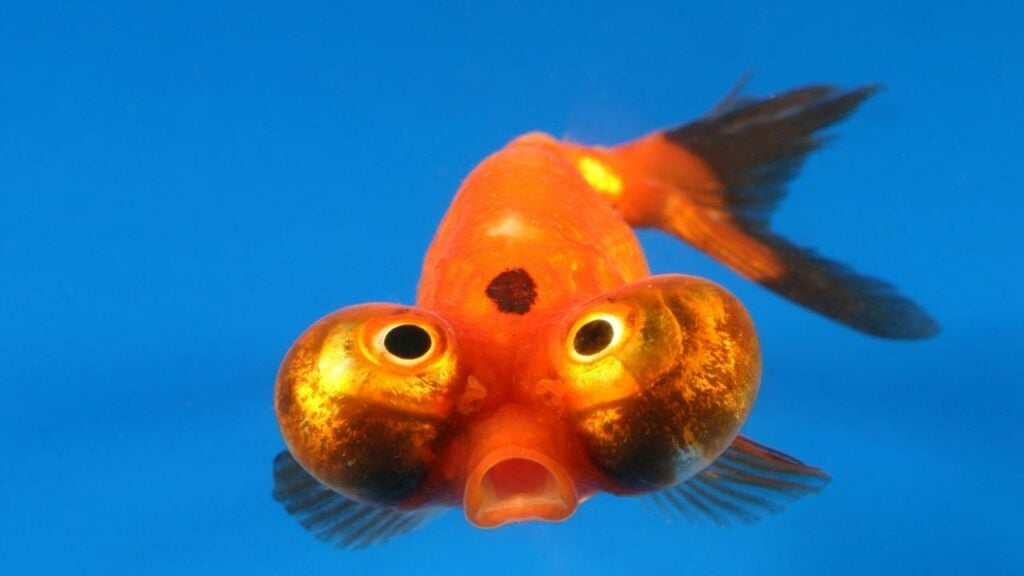
- Name / Scientific Name: Celestial Eye Goldfish / Carassius auratus
- Care Level: Intermediate
- Temperament: Peaceful
- Maximum Size: 6 inches
- Minimum Tank Size: 20 gallons
- Diet: Omnivore
- Water Temperature: 65°-72°F
- dKH: 5-19
- pH: 7.0-8.0
Known as the Stargazer in China, the celestial eye goldfish has eyes pointing upwards. Along with the bubble eye, the celestial eye certainly is an unusual-looking goldfish.
Peaceful in nature, growing to around 5-6 inches, the celestial eye comes in several color variations including black, calico, pearl, red, red and white, and plain white.
Its poor vision due to its eye placement, and lack of a dorsal fine, means the celestial eye is a slow swimmer and not the most agile of fish.
With that in mind, tank mates again should be chosen carefully. They must be peaceful and not outcompete them for food.
Not a fish for a newbie. Being quite high maintenance they’re very sensitive to water quality and vulnerable to many diseases and injuries. This also makes them unsuitable for ponds.
You also need to be mindful of your aquarium lights being too bright due to their upward-facing eyes.
4. Egg Fish Goldfish
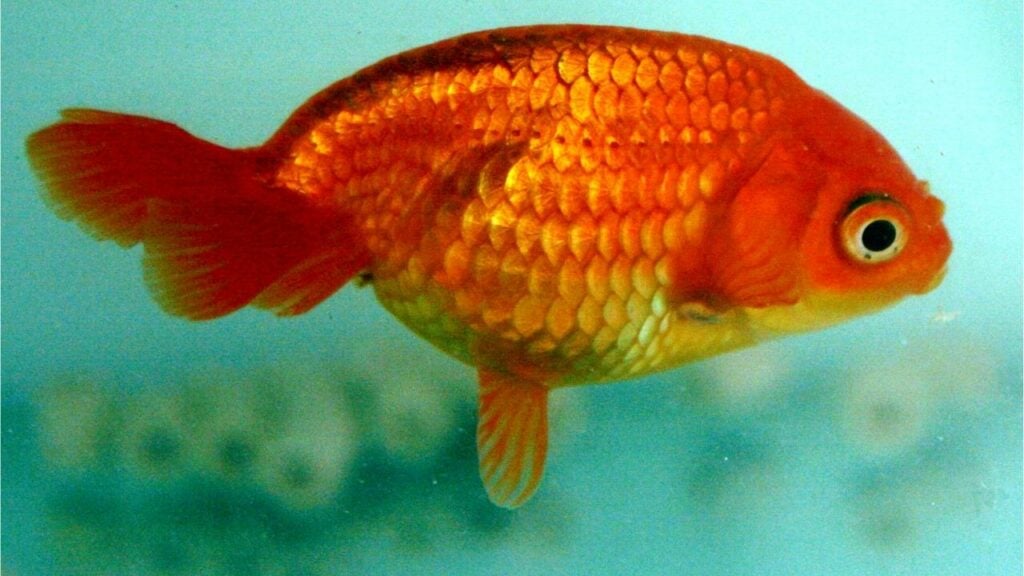
- Name / Scientific Name: Egg Fish Goldfish / Carassius auratus
- Care Level: Easy
- Temperament: Peaceful
- Maximum Size: 6 inches
- Minimum Tank Size: 20 gallons
- Diet: Omnivore
- Water Temperature: 68°-74°F
- dKH: 5-19
- pH: 7.0-8.0
As the name suggests, the egg fish goldfish is shaped like an egg. Coloration is gold, red, white, or bi-colored.
Very friendly with other goldfish, and needs to have company, a lone egg fish will not make a happy pet.
They are easy to care for, provide clean water, plenty of swimming space, and a few tank mates and you’ll have a happy egg fish.
Being a slow swimmer due to the lack of a dorsal fin, make sure tank mates are of similar swimming abilities.
There is a long-tailed variation of the egg fish which is called the Phoenix egg fish.
5. Fantail Goldfish
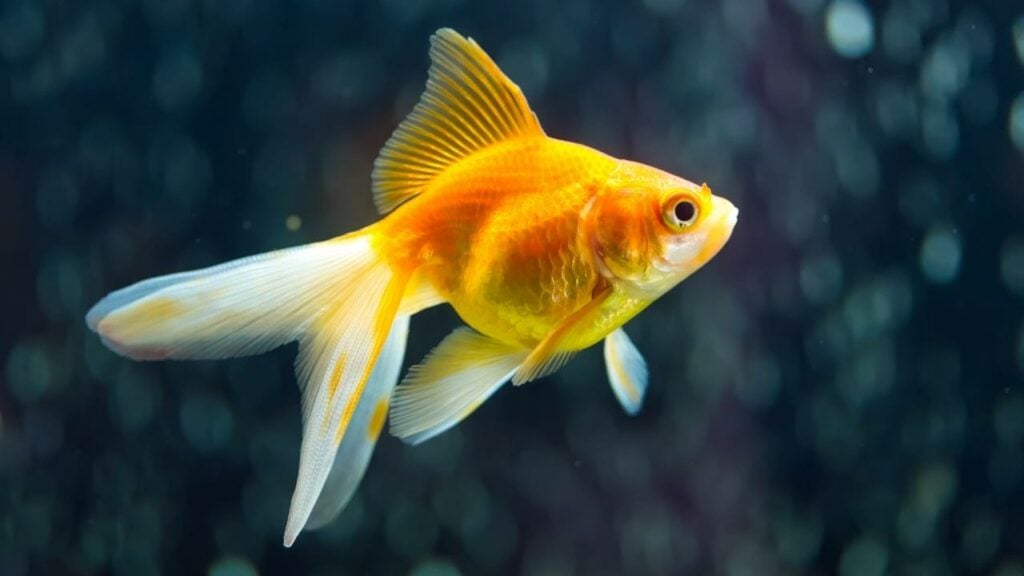
- Name / Scientific Name: Fantail Goldfish / Carassius auratus
- Care Level: Easy
- Temperament: Peaceful
- Maximum Size: 6-8 inches
- Minimum Tank Size: 20 gallons
- Diet: Omnivore
- Water Temperature: 65°-72°F
- dKH: 4-20
- pH: 7.0-8.0
It’s easy to see why the fantail is such a favorite in the aquarium and pond hobby. It’s a stunning-looking fish that is easy to care for and is super peaceful.
Growing up to a maximum size of 8 inches, it’s the long flowing tail that adds most of that length. The fantail’s body will fit in your hand.
They come in all of the common goldfish colors of orange, yellow, and red, and some uncommon colorings like black, blue, and white.
Like the egg fish, the fantail loves company. Avoid aggressive fin nipping tank mates and fish that are fast swimmers that will out-compete the fantail for food.
6. Jikin Goldfish
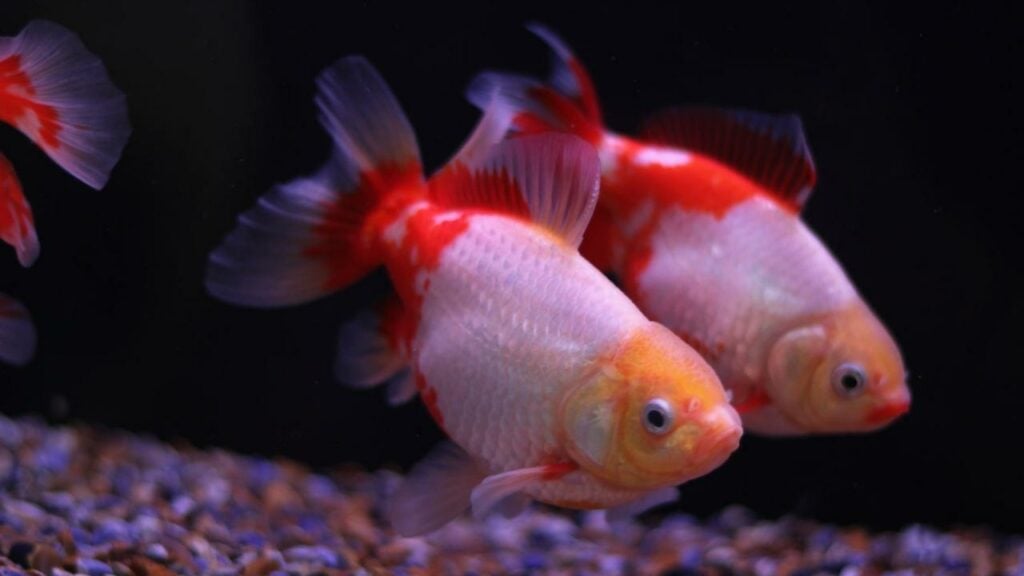
- Name / Scientific Name: Jikin Goldfish / Carassius auratus
- Care Level: Easy
- Temperament: Peaceful
- Maximum Size: 9 inches
- Minimum Tank Size: 30 gallons
- Diet: Omnivore
- Water Temperature: 65°-78°
- dKH: 5-19
- pH: 7.0-8.0
Also known as the peacock goldfish, the jikin is a very easy fish to care for and is great for a community aquarium due to its peaceful nature.
Although considered a small goldfish, the jikin will grow to around 9 inches in length so you need to buy a suitably sized tank from the start, or you’ll end up having to upgrade later.
The coloration is white with red. The red color will turn orange as the fish ages.
Be aware if you’re considering a jikin, they don’t come cheap as they are very hard to get hold of.
You won’t find them in your local pet store so you’ll have to shop online for one. Most breeders are based in Japan so you may have a hard time getting one into your aquarium.
They can live in a pond, but given the difficulty and cost of obtaining one, I wouldn’t risk it. Imagine looking out of your window and seeing a raccoon or bird making a snack out of your jikin!
7. Lionhead Goldfish
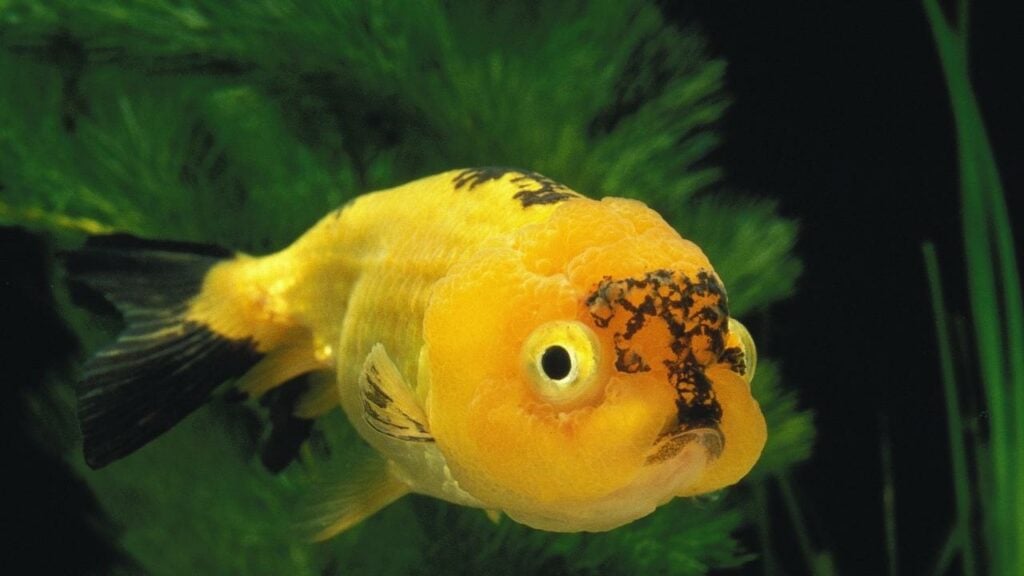
- Name / Scientific Name: Lionhead Goldfish / Carassius auratus
- Care Level: Intermediate
- Temperament: Peaceful
- Maximum Size: 5-8 inches
- Minimum Tank Size: 20 gallons
- Diet: Omnivore
- Water Temperature: 65°-72°F
- dKH: 5-19
- pH: 7.0-8.0
The lionhead is a super cute goldfish that was bred in China to resemble the mythical lion-dog. It’s another member of the egg-shaped body with no dorsal fin club.
It’s very similar in appearance to the Japanese ranchu further down this list. The way to tell them apart is the lionhead has a much flatter back and less of an angle where the tail joins the body.
The short rounded body and lack of a dorsal fin make the lionhead a slow swimmer. It needs to be housed with other slow-swimming fish so it doesn’t get outcompeted for food.
Lionheads are usually colored bold red and orange. However, it’s also available in black, blue, yellow, tri-colored, calico, and many other colors.
Despite being peacefully natured, I don’t recommend the lionhead for beginners as they are very sensitive to poor water quality.
8. Oranda Goldfish
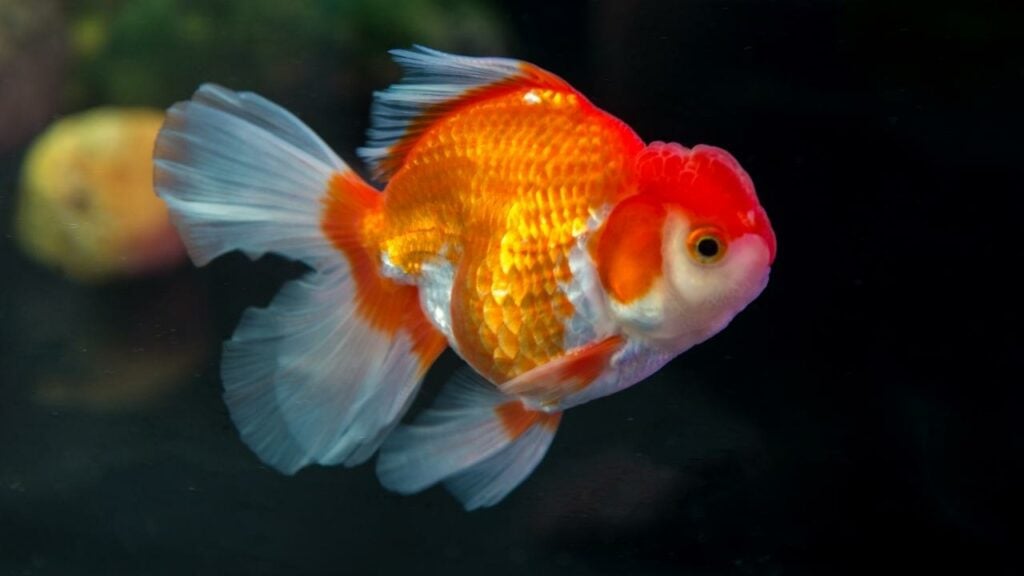
- Name / Scientific Name: Oranda Goldfish / Carassius auratus
- Care Level: Intermediate
- Temperament: Peaceful
- Maximum Size: 7-9 inches
- Minimum Tank Size: 20 gallons
- Diet: Omnivore
- Water Temperature: 65°-72°F
- dKH: 5-19
- pH: 7.0-8.0
A very popular choice amongst the fancy goldfish varieties is the oranda.
The top of the oranda’s head is an overgrown fleshy lump that can resemble a flat cap.
Comes in a wide array of colorings including orange, red, red-and-white, red-and-black, black, blue, chocolate, bronze, white, silver, black and white, red black and white, and calico.
These fish do well in schools of their own kind. Growing to around 9 inches you’ll need a large tank.
The 20-gallon minimum is for a single oranda, but you may need to upgrade to a bigger tank even with just 1 of them.
Tank mates should be other goldfish that can’t outswim the oranda at feeding time, and no fin nipping fish.
Smaller fish that can fit in the oranda’s mouth will become tasty snacks, as will freshwater snails.
The oranda isn’t suited for life in a pond, as the water can get too cold for them.
9. Pearlscale Goldfish
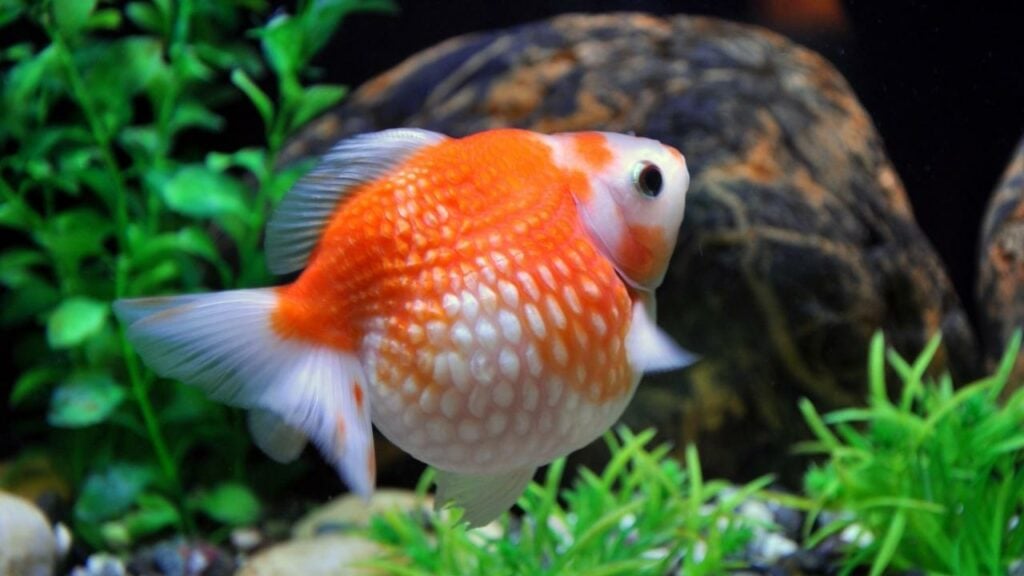
- Name / Scientific Name: Pearlscale Goldfish / Carassius auratus
- Care Level: Easy
- Temperament: Peaceful
- Maximum Size: 6-8 inches
- Minimum Tank Size: 20 gallons
- Diet: Omnivore
- Water Temperature: 65°-75°F
- dKH: 4-20
- pH: 6.5-7.5
The pearscale goldfish, also known as the ping pong or golfball goldfish, has a very distinctive look with its very rounded belly.
Beginner friendly as they’re hardy and peaceful with other peaceful fish, but don’t expect these guys to be darting around your tank or pond.
Peracsales come in various colors like black, blue, calico, chocolate, red, orange, white, and bi-colored varieties.
The rounder body develops as the fish ages, if you didn’t know this, you would be forgiven for thinking your fish is developing dropsy.
Due to being very slow swimmers, you should only add other slow swimming tank mates.
Pearscales require a lot of oxygen in their water. Plants such as anacharis, anubias, and java fern will help with this.
10. Pompon Goldfish
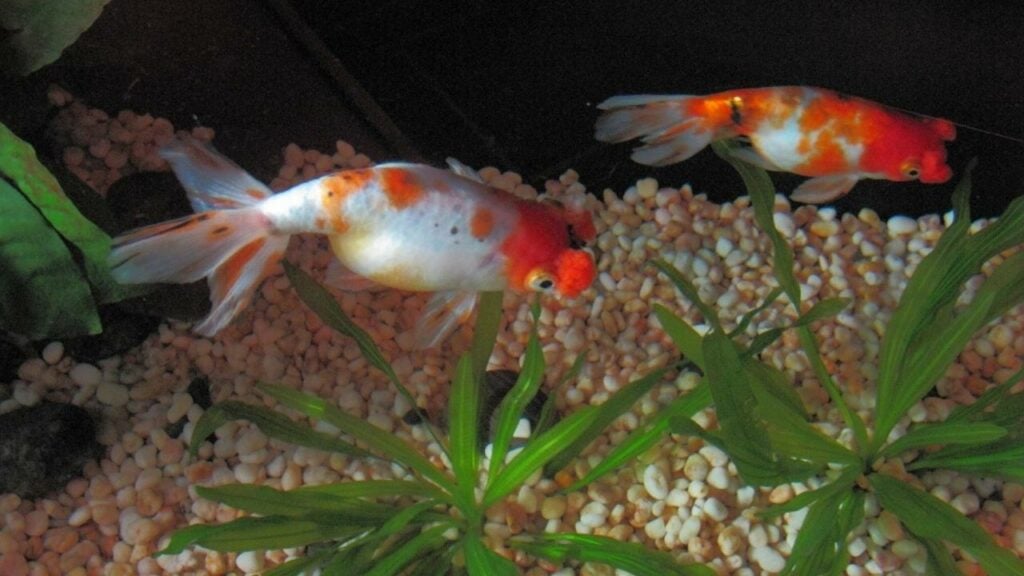
- Name / Scientific Name: Pompon Goldfish / Carassius auratus
- Care Level: Intermediate
- Temperament: Peaceful
- Maximum Size: 6 inches
- Minimum Tank Size: 20 gallons
- Diet: Omnivore
- Water Temperature: 65°-72°F
- dKH: 5-19
- pH: 7.0-8.0
The Pompon goldfish is instantly recognizable by the growths on its nose.
Another member of the egg-shaped body with no dorsal fin club, they are available in black, blue, brown, red, orange, and yellow colorings.
They are often referred to as the pompom goldfish due to the nasal growths resembling pom poms. However, the correct name for them is pompon.
The nasal growths start to appear around 5-6 weeks of age and take quite a while to develop fully.
The growths can become quite large and are vulnerable to being damaged from bumping into things or being hit by faster swimming fish. They can also hang down over the mouth which can hinder feeding and breathing.
Pompons are not suitable for life in a pond.
Tank mates should be other pompons or similar-bodied goldfish that won’t out-compete the pompon for food.
11. Ranchu Goldfish
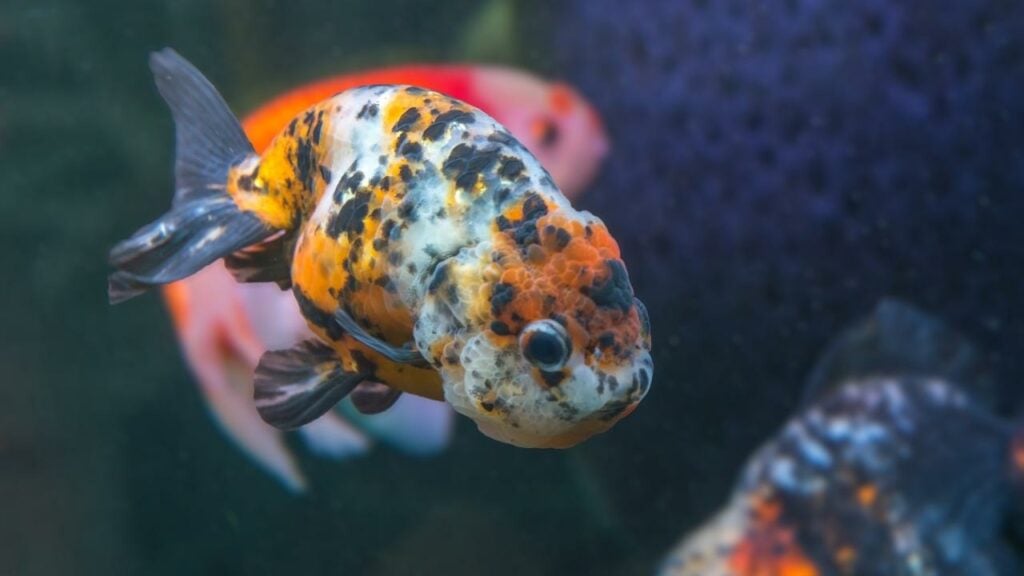
- Name / Scientific Name: Ranchu goldfish / Carassius auratus
- Care Level: Intermediate
- Temperament: Peaceful
- Maximum Size: 5-8 inches
- Minimum Tank Size: 20 gallons
- Diet: Omnivore
- Water Temperature: 65°-72°F
- dKH: 5-19
- pH: 7.0-8.0
The ranchu’s face reminds me of the rancor in Jabba the Hutt’s palace in Return of the Jedi.
Regarded as the “King of Goldfish” in Japan, the ranchu is available in black, calico, gold, red, orange, and white colorings.
Although closely resembling the lionhead, you can tell a ranchu from its prominently arched back and the acute angle where the body and tail meet.
Nice and friendly the ranchu may be, but it’s not recommended for beginners as it’s very sensitive to dirty water conditions.
It’s no Michael Phelps when it comes to speed, so tank mates should be other ranchus, lionheads, or similar peaceful slow swimmers.
There is a hybrid of the lionhead and ranchu available, called the lionchu. It has the head and tail of a lionhead and the body of a ranchu.
12. Ryukin Goldfish
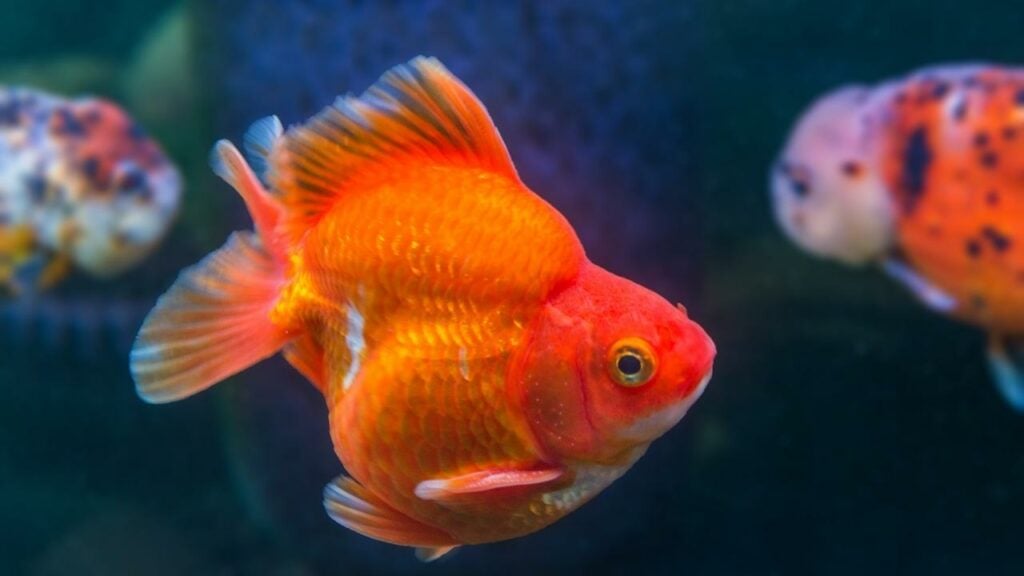
- Name / Scientific Name: Ryukin Goldfish / Carassius auratus
- Care Level: Easy
- Temperament: Semi Aggresive
- Maximum Size: 10 inches
- Minimum Tank Size: 20 gallons
- Diet: Omnivore
- Water Temperature: 65°-72°F
- dKH: 5-19
- pH: 7.0-8.0
The ryukin is a Japanese version of the fantail goldfish that is suitable for both aquariums and ponds.
Like the fantail, they have a rounded body, but their defining feature is the hump that starts right behind the head, giving the ryukin a very distinct appearance.
Growing up to 10 inches, make sure you buy a big tank so you don’t need to upgrade to a larger one down the line.
The ryukin comes in various colorations including brown, calico, red, red and white, white, and tri-color.
Temperament wise the ryukin can be a little aggressive towards faster swimming fish and can be a jerk with the more laidback goldfish like the bubble eye and celestial eye.
Recommended tank mates are more ryukins, fantails, lionheads, ranchus, and orandas.
13. Tamasaba Goldfish

- Name / Scientific Name: Tamasaba / Carassius auratus
- Care Level: Easy
- Temperament: Peaceful
- Maximum Size: 10 inches
- Minimum Tank Size: 20 gallons
- Diet: Omnivore
- Water Temperature: 50°-82°F
- dKH: 5-25
- pH: 7.0-8.0
The tamasaba is a sight to behold! It’s also known as the Yamagata goldfish as it originates from the Yamagata Prefecture in Japan.
Very easy to care for, suitable for both aquariums and ponds, and very peaceful, the tamasaba would be one of the best choices for a new fish keeper.
I say ‘would’ as it’s quite difficult to get hold of outside of its native Japan. If you can get hold of one, don’t expect it to come cheap, but you’ll be the envy of goldfish keeping buddies!
The coloration is exclusively white and red.
Shaped similarly to the ryukin, its hump isn’t as pronounced, and it has a tail similar to that of mackerel, which is why it is also known as the mackerel tail goldfish.
A sociable fish that can live with its own kind, sabao goldfish, similarly sized and swimming ability fish, or koi.
The tamasaba is often mixed up with sabao goldfish, but they are 2 different fish.
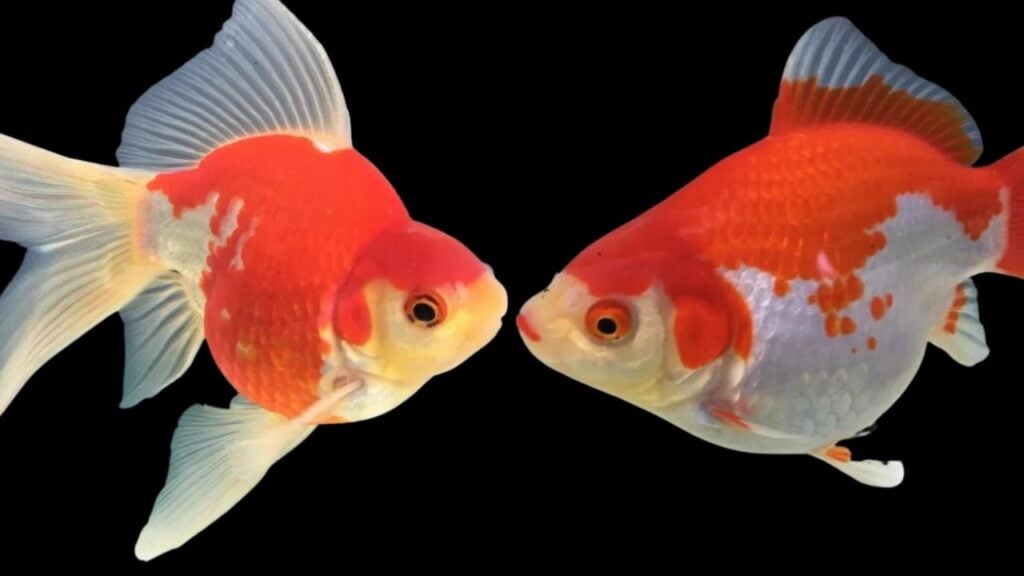
14. Telescopic / Moor Goldfish

- Name / Scientific Name: Telescopic / Moor Goldfish / Carassius auratus
- Care Level: Easy
- Temperament: Peaceful
- Maximum Size: 10 inches
- Minimum Tank Size: 20 gallons
- Diet: Omnivore
- Water Temperature: 65°-72°F
- dKH: 5-19
- pH: 7.0-8.0
The telescopic goldfish is a very popular choice amongst fancy goldfish keepers with their bulging eyes giving them a very distinct look.
As long as you take into account how easily their eyes can be damaged when setting up a tank for a telescopic goldfish, they’re fine for a new fish keeper.
They generally grow to around 6-8 inches, but some have been known to reach 10 inches, so the 20-gallon tank will probably need to be upgraded in the future.
There are several different colors of telescopes including blue, chocolate, calico, red, white, bi-color, and tri-color.
Due to fragile eyes and poor eyesight, tank mates should be non-fin nippers and slow swimmers. Other telescopes, black moors, celestial eyes, and bubble eyes will work best.
The black moor goldfish is a variety of telescopic goldfish that’s all black and its eyes don’t protrude out as far.
15. Tosakin Goldfish

- Name / Scientific Name: Tosakin Goldfish / Carassius auratus
- Care Level: Intermediate – Advanced
- Temperament: Peaceful
- Maximum Size: 6 inches
- Minimum Tank Size: 36″ L x 24″ Wide
- Diet: Omnivore
- Water Temperature: 65°-72°F
- dKH: 5-19
- pH: 7.0-8.0
The very rare tosakin goldfish was almost made extinct following the heavy bombing of Japan during WW2. Legend has it that only 6 of them were left!
This fish is not suitable for a new fish keeper, or life in a pond. Due to the heavy inbreeding that’s had to be done to save the breed from extinction, tosakins are very fragile and prone to many illnesses.
The tosakin is meant to be viewed from above. Sideways on they look like just another goldfish. You need to see them from above to appreciate their magnificent tails, which is what they’re bred for.
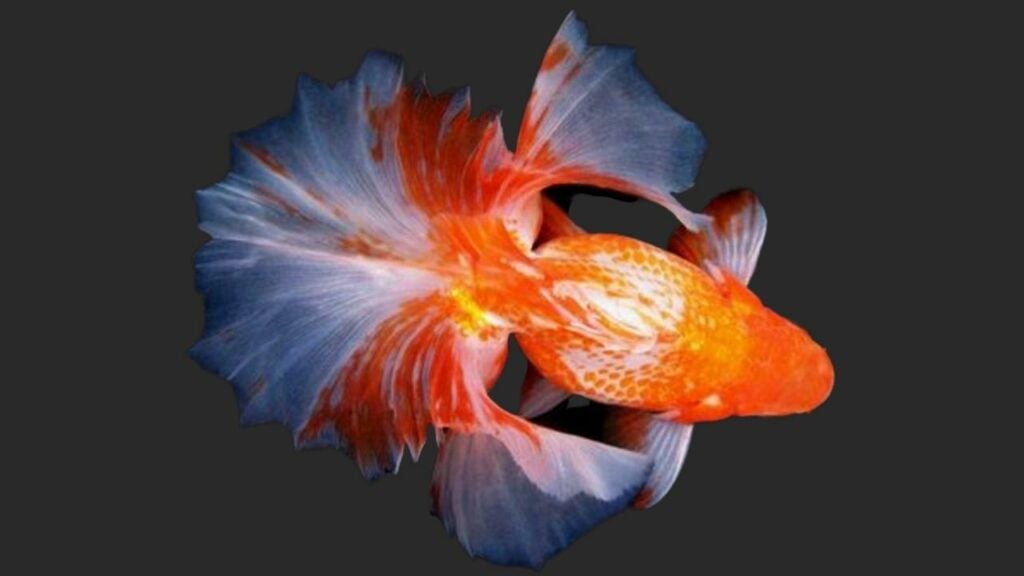
Color variations include black, calico, orange, orange and white, red, red and white, and yellow.
Tank size for the tosakin isn’t measured in minimum gallons, but instead in minimum dimensions. It should be wide and at least 6 times the length of an adult fish. Tosakin experts recommend a tank that’s at least 36″ in length x 24″ in width.
Very friendly fish but due to being a terrible swimmer it needs slower swimming tank mates. Other tosakins, ranchus, lionheads, telecopics, etc are all suitable options.
16. Veiltail Goldfish
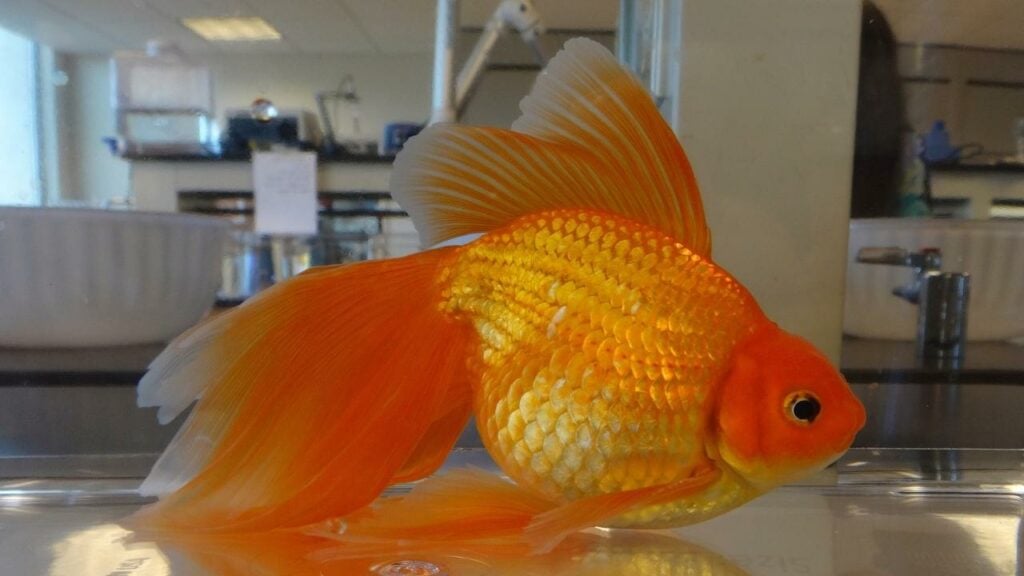
- Name / Scientific Name: Veiltal Goldfish / Carassius auratus
- Care Level: Intermediate
- Temperament: Peaceful
- Maximum Size: 7 inches
- Minimum Tank Size: 20 gallons
- Diet: Omnivore
- Water Temperature: 65°-72°F
- dKH: 5-19
- pH: 7.0-8.0
Next up is the rare and fragile veiltail. You’ve probably already guessed, it’s not suitable for a beginner.
Its short rounded body leads to buoyancy problems and the long flowing fins are damaged very easily.
The veiltails coloration can be brown, calico, red, orange, variegated, or white.
Often mistaken for the fantail, the veiltail has a rounder body, a longer tail, and a longer dorsal fin.
Very friendly fish that won’t win the race to food at feeding time. Tank mates need to be other slow swimmers like the lionhead, ranchu, telescopics, etc.
17. Wakin Goldfish

- Name / Scientific Name: Wakin Goldfish / Carassius auratus
- Care Level: Easy
- Temperament: Peaceful
- Maximum Size: 10 inches
- Minimum Tank Size: 30 gallons
- Diet: Omnivore
- Water Temperature: 65°-72°F
- dKH: 5-19
- pH: 7.0-8.0
Last up is the wakin (pronounced wa-keen) goldfish.
The wakin has a long slender body like a comet goldfish but has a tail fin similar to that of the fantail.
The coloration of the wakin is brown, calico, orange, red, red and white, and white.
Very peaceful fish that’s suitable for both aquariums and ponds.
Growing to 10 inches in an aquarium, make sure you get a large tank (30 gallons minimum) for a single wakin. They can grow up to 18 inches in a pond!
Due to having a longer elongated body, they’re fast swimmers so they’re not suitable as tank mates for slower swimmers like telescopics, moors, lionheads, ranchus, etc.
The best choice of tank mates for the wakin are comets, koi, and shubunkins.
Things To Consider Before Getting A Small Goldfish
There are a few things to consider before getting a goldfish and setting up the tank correctly will ensure they have a long and healthy life.
Small Goldfish Tank Size
The number 1 consideration when buying yourself a goldfish, even a small one, is tank size.
You should buy the biggest tank that’s within your budget and have space for.
You may have heard that a goldfish will only grow to the size of its tank.
While there is some truth in that statement, what’s actually happening is the goldfish’s growth is being stunted, which can lead to them having deformities and serious long-term health problems in the future.
You should get a minimum of 20-30 gallons for a single goldfish (you may still have to upgrade to a larger tank later as your fish grows) and allow an additional 10 gallons per additional fish, if you want a community tank.
Goldfish create a lot of waste and can quickly crash your nitrogen cycle if you have too many fish in one tank or a single fish in a tank that’s way too small.
The larger the tank, the easier it is to keep your nitrogen cycle stable.
A 40 gallon breeder tank is a great place to start for 1 or 2 small goldfish.
Goldfish prefer to swim horizontally rather than vertically. A 40-gallon breeder tank is wider and shallower than regular aquariums, so they have more space for your goldfish to swim in.
The wider dimensions also provide more water surface area which is great for oxygen transfer.
Just like with any other fish, you must cycle your tank before adding your goldfish.
How Many Small Goldfish In A 20 Gallon Tank?
You should keep just 1 small goldfish in a 20-gallon tank.
How Long Do Small Goldfish Live?
With the right care, a small goldfish’s lifespan could be anywhere from 10-15+ years.
Tank Filtration
Goldfish make a ton of mess, so choose a filter that can process the waste efficiently.
A high-quality HOB filter or canister filter will do a great job of keeping the water nice and clean.
Make sure to get one with a flow rate that’s adjustable as fancy goldfish don’t like high water flow in their tanks due to their lack of mobility.
A great natural way to filter the water is by adding live plants. Pothos is a great choice for goldfish, as is duckweed as they love to eat it and it does a great job of absorbing nitrates.
You’ll also need to know how to clean a goldfish tank properly and set up a regular tank maintenance schedule.
Tank Decor
Most fancy goldfish have very delicate long flowing fins that can easily be damaged by sharp objects and rough edges.
File down any sharp points on decor items, and use smooth gravel or glass beads as your substrate or you can leave the tank bare-bottomed, which makes cleaning much easier.
Diet
When it comes to fancy goldfish food, they are omnivores so will eat anything you give them.
My top tip is to feed them food that sinks in the water.
Fancy goldfish are notorious for taking in excess air whilst feeding at the water’s surface which can lead to buoyancy issues.
Along with a high-quality pellet, some other foods to supplement your goldfish’s diet with are:
- Algae wafers
- Brine shrimp
- Bloodworms
- Daphnia
- Kale
- Lettuce
- Shelled peas
- Spinach
- Zucchini
As a tasty occasional treat, you can also feed them blueberries, strawberries, or watermelon in moderation.
If you really want to spoil them with a highly nutritious meal, you can make your own fish food that they will eagerly gobble down!
Goldfish Tank Mates
You can mix different types of fish with goldfish, as long as they have a peaceful temperament, can handle the cooler water of a goldfish tank, and won’t outcompete the goldfish for food.
A slender-bodied fish can swim much faster than a rounded fancy goldfish and will therefore always get to the food first leaving the fancy goldfish starving.
Faster swimming fish can also bump into the slower swimmers and could spook or injure them.
I often see people asking ‘Can goldfish live with betta fish?’, the simple answer is no, because they have different tank setup requirements.
Fin nippers must be avoided. Fish like barbs (especially tigers), cichlids, bettas, single-tail goldfish, and certain tetras will nip at their fins and terrorize them!
Some of the best goldfish tankmates are:
- Bristlenose pleco
- Dojo loach
- Hillstream loach
- Platy fish
- Rubberlip pleco
- White cloud mountain minnows
Closing Thoughts On Smallest Types Of Goldfish…
Now you know what small goldfish breeds are available, there’s bound to be at least one that you like the look of.
If you’ve decided a goldfish isn’t the right fish for you, check out my best freshwater fish post for some great alternatives.

